Our indexes include entries for the spelling mead. In the period you have requested, we have the following 900 records (displaying 851 to 860):
British Civil Servants
(1940)
The British Imperial Calendar lists civil servants in Britain, arranged according to the organizational structure of the state, and shows their qualifications and salaries. | Sample scan, click to enlarge
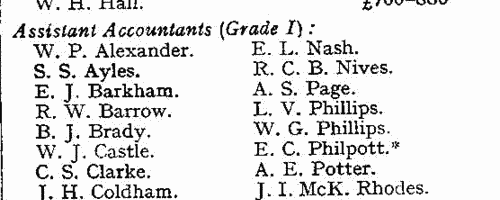
|
Imperial Service Medal
(1940)
The Central Chancery of the Orders of Knighthood at St James's Palace announced these awards by king George VI of the Imperial Service Medal to members of the Home Civil Service. The names are arranged alphabetically by surname (in capitals) and christian names, with office or rank in the service. | Sample scan, click to enlarge
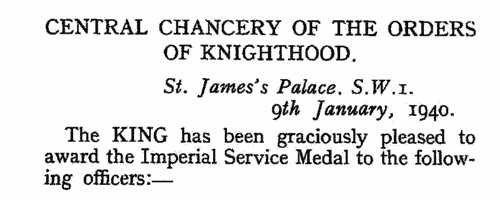
|
Imperial Service Medal
(1942)
The Central Chancery of the Orders of Knighthood at St James's Palace announced these awards by king George VI of the Imperial Service Medal to members of the Home Civil Service. The names are arranged alphabetically by surname (in capitals) and christian names, with office or rank in the service. | Sample scan, click to enlarge
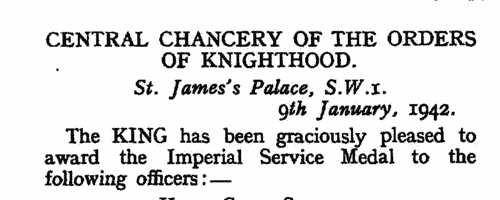
|
Imperial Service Medal
(1943)
The Central Chancery of the Orders of Knighthood at St James's Palace announced these awards by king George VI of the Imperial Service Medal to members of the Home Civil Service. The names are arranged alphabetically by surname (in capitals) and christian names, with office or rank in the service. | Sample scan, click to enlarge
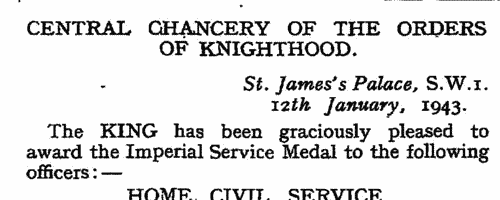
|
Royal Corps of Signals: Regular Army Emergency Commissions: Lieutenants
(1946)
The Army List for October 1946 lists the 4300 officers of the Royal Corps of Signals by rank and seniority (i.e., the date from which their particular rank was to be reckoned). The names are given as surnames and initials. The many temporary commissions bestowing brevet or higher rank are listed in italics, with date, together with any decorations. In front of the surnames three abbreviations may occur: a bold R, meaning released to unemployment; a crossed-swords symbol for meritorious war service; and a pilcrow, for service without pay and allowances. There are separate sections for retired officers temporarily re-employed, the Territorial Army, and Regular Army Emergency Commissions (including African Colonial, Caribbean, Egypt and Palestine forces), Supplementary Reserve Category B.
| Sample scan, click to enlarge
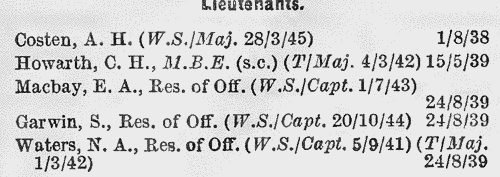
|
Associate Members of the Institution of Mechanical Engineers (A. M. I. Mech. E.)
(1947)
The Institution of Mechanical Engineers, founded in 1847, was incorporated by royal charter in 1930. The list of members of 1 March 1947 gives the names (surname first) and addresses of the seven classes of member - Honorary Members (Hon. M. I. Mech. E.); Members (M. I. Mech. E.); Associate Members (A. M. I. Mech. E.); Companions (C. I. Mech. E.); Associates (A. I. Mech. E.); Graduates (G. I. Mech. E.); and Students (S. I. Mech. E.). The year of attaining qualification is given in the left-hand margin; in the higher grades the years of achieving the lower grades are also given, bracketed together. The crossed swords symbol indicates naval or military service during the Great War of 1914-1918; an italic b shows a member of the Benevolent Fund. (p) after a Graduate's or a Student's name indicates one who had passed the whole of the A. M. Examination or its recognized equivalent. | Sample scan, click to enlarge
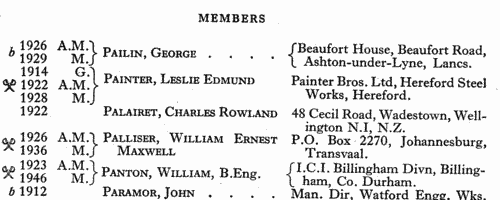
|
Members of the Institution of Mechanical Engineers (M. I. Mech. E.)
(1947)
The Institution of Mechanical Engineers, founded in 1847, was incorporated by royal charter in 1930. The list of members of 1 March 1947 gives the names (surname first) and addresses of the seven classes of member - Honorary Members (Hon. M. I. Mech. E.); Members (M. I. Mech. E.); Associate Members (A. M. I. Mech. E.); Companions (C. I. Mech. E.); Associates (A. I. Mech. E.); Graduates (G. I. Mech. E.); and Students (S. I. Mech. E.). The year of attaining qualification is given in the left-hand margin; in the higher grades the years of achieving the lower grades are also given, bracketed together. The crossed swords symbol indicates naval or military service during the Great War of 1914-1918; an italic b shows a member of the Benevolent Fund. (p) after a Graduate's or a Student's name indicates one who had passed the whole of the A. M. Examination or its recognized equivalent. | Sample scan, click to enlarge
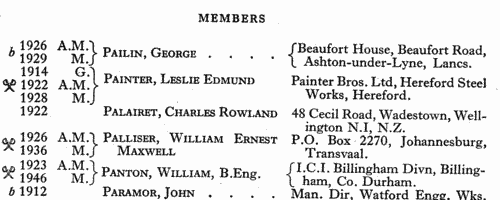
|
Students of the Institution of Mechanical Engineers (S. I. Mech. E.)
(1947)
The Institution of Mechanical Engineers, founded in 1847, was incorporated by royal charter in 1930. The list of members of 1 March 1947 gives the names (surname first) and addresses of the seven classes of member - Honorary Members (Hon. M. I. Mech. E.); Members (M. I. Mech. E.); Associate Members (A. M. I. Mech. E.); Companions (C. I. Mech. E.); Associates (A. I. Mech. E.); Graduates (G. I. Mech. E.); and Students (S. I. Mech. E.). The year of attaining qualification is given in the left-hand margin; in the higher grades the years of achieving the lower grades are also given, bracketed together. The crossed swords symbol indicates naval or military service during the Great War of 1914-1918; an italic b shows a member of the Benevolent Fund. (p) after a Graduate's or a Student's name indicates one who had passed the whole of the A. M. Examination or its recognized equivalent. | Sample scan, click to enlarge
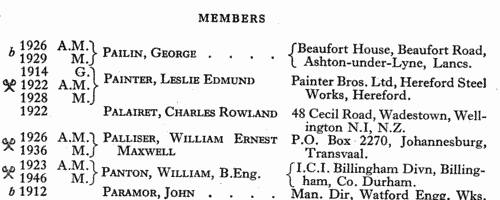
|
Imperial Service Medal
(1948)
The Central Chancery of the Orders of Knighthood at St James's Palace announced these awards by king George VI of the Imperial Service Medal to members of the Home Civil Service. The names are arranged alphabetically by surname (in capitals) and christian names, with office or rank in the service. | Sample scan, click to enlarge
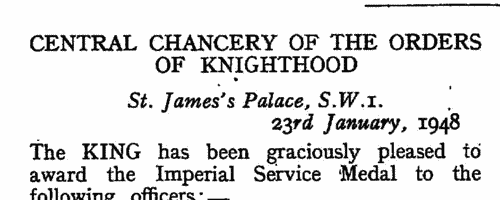
|
British Dentists
(1950)
The Dentists Register is the official register of British dental practitioners. For each dentist the original certificate number is given; name (surname first, in bold; in the case of married women, maiden name is also usually given); address (in italics); date of registration; and the qualification entitling registration, with any additional qualifications, with year and place of qualification. Many of the older dentists, already practising by 1921, were qualified by virtue of the Dentists Act of that year. | Sample scan, click to enlarge

|
Research your ancestry, family history, genealogy and one-name study by direct access to original records and archives indexed by surname.











